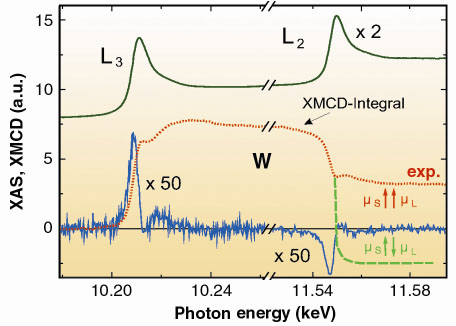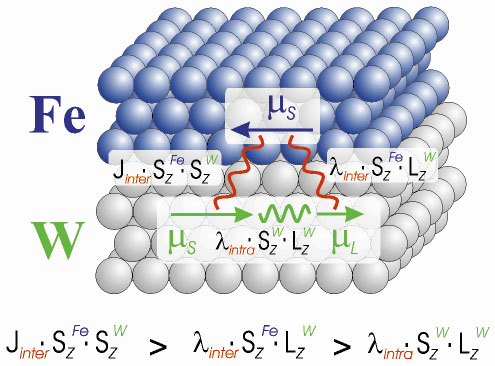- Home
- Users & Science
- Scientific Documentation
- ESRF Highlights
- ESRF Highlights 2001
- Magnetism and Electronic Properties of Solid
- Systematics of the Induced Magnetic Moments in 5d Layers and the Violation of Hund's Third Rule
Systematics of the Induced Magnetic Moments in 5d Layers and the Violation of Hund's Third Rule
Magnetic multilayers are formed by periodic alternation of ferromagnetic and non-magnetic layers. A large fraction of the atoms are located at the interfaces, and two-dimensional directly-coupled non-magnetic layers are formed facing a ferromagnetic layer. This special configuration allows the tailoring of magnetic moments, magnetic anisotropy, magneto-optics and magneto-transport properties for each application. Here we focus on the induced magnetic moments of the 5d elements in magnetic multilayers. While induced magnetic moments in alloys have been studied previously, it was difficult to separate the small induced moments from the total magnetisation in ultrathin magnetic structures due to the lack of element-specific techniques with monolayer sensitivity. The experimental technique that allows one to study the induced magnetism is X-ray Magnetic Circular Dichroism (XMCD), which provides quantitative information on spin and orbital magnetic moments of the absorbing atom in both amplitude and direction. It is demonstrated that the induced magnetism in magnetic multilayers may be radically different from that in alloys due to the different geometry and electronic structure and so unexpected phenomena may be observed.
 |
Fig. 90: Normalised XAS (top) and XMCD (bottom) spectra at the L3,2 edges of W. For better illustration, the XMCD spectra have been multiplied by 50, while the XAS spectra have been shifted vertically. The XMCD integrals (dotted line = measured and dashed line = hypothetical) serve to visualise the relative orientation of µL and µS. |
In Figure 90 we plot the normalised X-ray absorption (XAS) and X-ray magnetic circular dichroism (XMCD) spectra at the L3,2 edges of W in a Fe/W magnetic multilayer with 3 monolayers of W in each period. The spectra were recorded at ID12 using the total fluorescence detection mode. The XMCD signals are very small compared to XAS, as the large scaling factor of 50 reveals. However, the signal-to-noise ratios are still large due to the high photon flux and degree of polarisation offered at the ESRF. By knowing the direction of the magnetic field and the helicity of the beam we conclude that W is polarised antiparallel (AFM) to Fe, in agreement with previous reports for alloys. This behaviour is consistent with the general trend for the transition metals with a less-than-half-filled d shell. However, contrary to the third Hund's rule, the W spin µS and orbital µL magnetic moments are coupled in parallel (FM). This is visualised via the XMCD integrals in Figure 90. The measured integral (dotted line) does not change sign showing that µL/µS > 0. For a negative sign (AFM coupling) the XMCD integral should change sign as the hypothetical dashed line of Figure 90 reveals. This can not be understood in a single atomic picture. One has rather to consider interatomic spin-orbit coupling. We consider three types of interaction possible: (i) the largest is the spin-spin coupling between Fe and W, Jinter x SzFe x SzW, (ii) in addition, we have the classical intra-atomic spin-orbit coupling for W, intra x SzW x LzW. If this was all, µL should be AFM coupled to µS. To understand the opposite observation (FM coupling) one may propose (iii) an interatomic Fe-W spin-orbit interaction
inter x SzFe x LzW. As shown in Figure 91, we conclude the inequality that the interatomic spin-orbit coupling is smaller than the exchange coupling but larger than the intra-atomic spin-orbit coupling of W. Such an effect is attributed to hybridisation effects at the Fe/W interface [1].
 |
Fig. 91: Schematic representation of the Fe/W layers and the various type of interactions that one needs in order to describe the violation of the third Hund's rule in a simple atomic model. |
Results for the ratio µL/µS and the total moment µtot derived by application of the sum rules for the beginning (W) and the end (Ir,Pt) of the 5d series in magnetic multilayers are listed in Table 2 [2]. µL/µS is significant only for Pt ( ~0.2-0.3) revealing a large orbital magnetism contribution. Moreover, we find µtot ~0.2 µB/atom for both Ir and W, which is in fair agreement with recent ab initio calculations.
 |
Table 2: Data for the ratio µL/µS and the total magnetic moment µtot for three 5d elements (Pt, Ir, W). |
In conclusion, systematic trends for the induced magnetism of elements of the 5d series in multilayers are shown. These multilayers may serve as a demonstration of a prototype experimental case of a 'violation' of the pure intra-atomic Hund's rule picture, which can be understood via the existence of strong interatomic interactions at the 3d/5d interfaces.
References
[1] F. Wilhelm et al., Phys. Rev. Lett. 87, 207202 (2001).
[2] P. Poulopoulos et al., Phys. Stat. Sol. (a) (in press).
Authors
F. Wilhelm (a), P. Poulopoulos (a), H. Wende (a), A. Scherz (a), K. Baberschke (a), M. Angelakeris (b), N.K. Flevaris (b) and A. Rogalev (c).
(a) FUB, Berlin (Germany)
(b) AUTh, Thessaloniki (Greece)
(c) ESRF



